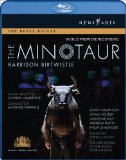| Reviews & Columns |
|
Reviews DVD TV on DVD Blu-ray 4K UHD International DVDs In Theaters Reviews by Studio Video Games Features Collector Series DVDs Easter Egg Database Interviews DVD Talk Radio Feature Articles Columns Anime Talk DVD Savant Horror DVDs The M.O.D. Squad Art House HD Talk Silent DVD
|
DVD Talk Forum |
|
|
| Resources |
|
DVD Price Search Customer Service #'s RCE Info Links |
|
Columns
|
|
|
Birtwistle: The Minotaur (Royal Opera House, 2008)
Opus Arte // Unrated // February 23, 2010
List Price: $45.98 [Buy now and save at Amazon]
The Performance:
Upon first hearing the word "minotaur", most people outline the physical image of the fabled beast -- a powerful part man, part bull abomination -- in their minds. Others gravitate to thoughts of a labyrinth, the maze-like lair on Crete where the Minotaur's legend originates in Grecian mythology (here's a review of a documentary on the historical context, The Minotaur's Island). That's the origin of Asterious' (Asterion) story, the "half-and-half" child of the gods and the focus of Harrison Birtwistle's highly-anticipated opera, The Minotaur. What he focuses on, with David Harsent's libretto in tow, is a level of unpredictable brashness within all its moving parts, compiling into a descent into the Minotaur's labyrinth that's as visually stunning while surrounded by the maze's tethered walls as it is expressively potent once we're fixated on Asterious' tragic state. OpusArte captures The Minotaur during performances at the Royal Opera House across three dates in 2008, shot in high-definition and actually clocking in at 135 minutes from start to curtain call.
The Minotaur doesn't start with that level of primeval resonance, as the preface to this story begins with Asterious' sister, Ariadne (Christine Rice), first giving us a soliloquy about the rattled neurosis revolving around the state of Grecian bloodshed, sacrifice, and her brother's involvement. Little more than a strip of sand with a bronze bull's head adorn the stage during her solo, later incorporating the sails of a boat as we're also introduced to a group of sacrificial beings brought for the Minotaur -- of which include Theseus (Johan Reuter), the man known as the ordained challenger to Asterious. These early moments in the opera, involving poetic exchanges between Rice and Reuter with face-painted, wild-eyed youths heightening the evocative tension, can be drawn out and decadent; it's hard not to lose at least a moderate amount of focus at their lengthy exchanges, even if Rice's throaty depth and Reuter's powerful chivalry still control our focus on their performances.
Once we descend into the labyrinth, however, The Minotaur brews into a grand display of manic bloodshed and psychological turmoil that grips our attention and never lets go, accompanied by assertive, billowing freeform scoring with Antonio Pappano conducting and minimal but gallant set design. Birtwistle uses unconventional scoring to give the production a maddening mood, a tactic that heightens the atmosphere's complexity where the set design's constraints aren't physically able. Scratched walls tower high with blood "graffiti" adorning them, as gaps within their construct allude to the rest of the winding labyrinth -- doubling as a clever prop retrieval point when the violence grows gruesome. A dark, visceral environment is constructed within this set design, with iridescent masks hovering above his arena for bloodshed as onlookers seemingly of both physical and metaphysical type.
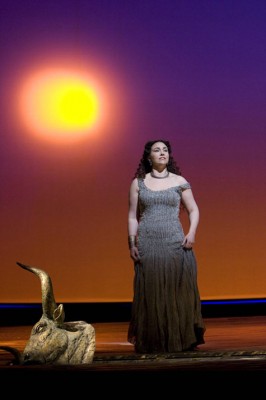 And then, we see our focal character. At first glimpse of furry, sturdily built John Tomlinson in his Minotaur's garb, with a head translucent to a degree that allows proper viewing of the performer's facial mannerisms, the gravity of the production immediately swells at the stage's central point and extracts the air clean from the room. Birtwistle sketched out the Minotaur's vocal essence with Tomlinson in mind, and the clarity and lack of compunction with his delivery speaks to that craftsmanship. Along with gasping, despondent turns from his victims lost in the labyrinth, the brazenly electric scenes where Tomlinson gores the scurrying sacrificial beings are operatic exploits of the highest accord. However, it's in the beast's maudlin visions of a part-dream, part-reality nature that we see glimpses of emotional gravity within Birtwistle's rhythmical and poetic take on the Grecian story.
And then, we see our focal character. At first glimpse of furry, sturdily built John Tomlinson in his Minotaur's garb, with a head translucent to a degree that allows proper viewing of the performer's facial mannerisms, the gravity of the production immediately swells at the stage's central point and extracts the air clean from the room. Birtwistle sketched out the Minotaur's vocal essence with Tomlinson in mind, and the clarity and lack of compunction with his delivery speaks to that craftsmanship. Along with gasping, despondent turns from his victims lost in the labyrinth, the brazenly electric scenes where Tomlinson gores the scurrying sacrificial beings are operatic exploits of the highest accord. However, it's in the beast's maudlin visions of a part-dream, part-reality nature that we see glimpses of emotional gravity within Birtwistle's rhythmical and poetic take on the Grecian story.
Spanning about fifteen minutes north of two hours in this showing, Birtwistle's flamboyantly chaotic creation becomes so entrancing -- both to the eyes and evocatively -- that the time rushes by. As harsh musical notes accompany lengthy back-and-forths between Ariadne and Theseus through the second half, the robust Cretan essence pours through in mock sunsets and highly subtle neon lighting, relishing in darkness as the cerebral complexity heightens. In flashes between their boisterous exchanges, Asterious' presence transcends more into a claustrophobic contemplation of his "neither-nor" presence as a Minotaur, dredging Tomlinson to and fro on the stage in an impawned battle with his own mind. A scene involving animal sacrifice seems to meander a bit as it bewilders with odd conceptualization, but still holds a perverse interest as we witness Ariadne's appeal to the gods.
It boils to an anticipated but tragically impressive conclusion that finds Tomlinson giving the Minotaur's fraught swan song in stunning fashion. The three-panel set design grows comfortable on our eyes, accepting the onlookers above and the flocking scavenger birds -- brilliantly brought to life via strong choreography and make-up/costume work -- as integral elements usurping the minotaur. Birtwistle takes his sweet time in bringing the lights down on Asterious' oddly emotional struggle between being a man-beast of burden, allowing garbled thoughts and passionate pleas for humanity to thrash while shackled by the whims of his creation. He's created something with this outlook on the medieval tale that's coarse and billowing, but also accessibly crafted for those simply intrigued by the Minotaur's lore.
The Blu-ray:
Video and Audio:
As with many of OpusArte's other high-definition releases, Birtwistle's The Minotaur arrives in a 1.78:1 1080i AVC encode that impresses, despite the misgivings that accompany its resolution discrepancy. It's naturally softer and doesn't move quite as effortlessly as a 1080p image, but that fact's quickly forgotten upon viewing the performance. Skin tones, textures in the Minotaur's head piece, and the many scratches in the wall behind the players are captured with precise detail. Contrast remains deep and pleasing, yet gradating downwards on the actors during spotlit sequences naturally.
Adorning the fine high-definition image, the DTS-HD MAster Audio track mirrors the visuals with sumptuousness that preserves the theatrical experience. John Tomlinson's vocals become a test for mid-range sound design, something that OpusArte's disc precisely handles. The rest of the vocals from Christine Rice and Johan Reuter are equally as powerful, though the audibility is naturally a few degrees lower than Tomlinson's robustness. Musically, I couldn't have asked for more from the presentation of the orchestra; thundering from the drums, fluctuating woodwinds, and the occasionally high-pitched shriek echo through the bizarre modernist concoction at play here, and it's magnificently pitched. Subtitles, which are fairly necessary, are available in stark-white text in English, French, German, Spanish, and Italian.
Special Features:
Aside from the Cast Gallery (:27) and a lengthy, solid plot Synopsis (7:19, HD AVC) that accompany most OpusArte releases, Birtwhistle's The Monitaur also comes with an enlightening feature entitled Myth is Universal (32:20, HD AVC). Interviews with the opera's crew, which include stage director Stephen Langridge, librette author David Harsent, actress Christine Rice, and Harrison Birtwistle himself adorn the feature, where they discuss the symbolism and structure of the Minotaur myth and what they had to do to shape the production.
Final Thoughts:
Within its brooding excitement, bold but streamline visual construction, and fixating trajectory across the Royal Opera House's stage that mixes static and brashly flailing motions to equal measure, Birtwistle's The Minotaur is a transfixing take of mythology that's astounding to behold. Its artistic whims and its performance potency craft it into an accessible and vocal-heavy Grecian tragedy, one that carries a certain poetry about its content. OpusArte's Blu-ray looks and sounds great, earning it a High Recommendation.
Thomas Spurlin, Staff Reviewer -- DVDTalk Reviews | Personal Blog/Site
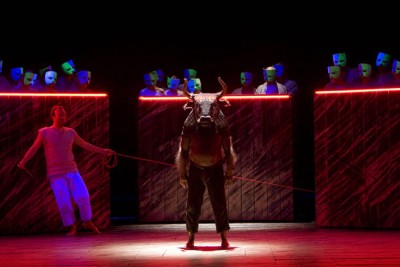 |
| |
The Minotaur doesn't start with that level of primeval resonance, as the preface to this story begins with Asterious' sister, Ariadne (Christine Rice), first giving us a soliloquy about the rattled neurosis revolving around the state of Grecian bloodshed, sacrifice, and her brother's involvement. Little more than a strip of sand with a bronze bull's head adorn the stage during her solo, later incorporating the sails of a boat as we're also introduced to a group of sacrificial beings brought for the Minotaur -- of which include Theseus (Johan Reuter), the man known as the ordained challenger to Asterious. These early moments in the opera, involving poetic exchanges between Rice and Reuter with face-painted, wild-eyed youths heightening the evocative tension, can be drawn out and decadent; it's hard not to lose at least a moderate amount of focus at their lengthy exchanges, even if Rice's throaty depth and Reuter's powerful chivalry still control our focus on their performances.
Once we descend into the labyrinth, however, The Minotaur brews into a grand display of manic bloodshed and psychological turmoil that grips our attention and never lets go, accompanied by assertive, billowing freeform scoring with Antonio Pappano conducting and minimal but gallant set design. Birtwistle uses unconventional scoring to give the production a maddening mood, a tactic that heightens the atmosphere's complexity where the set design's constraints aren't physically able. Scratched walls tower high with blood "graffiti" adorning them, as gaps within their construct allude to the rest of the winding labyrinth -- doubling as a clever prop retrieval point when the violence grows gruesome. A dark, visceral environment is constructed within this set design, with iridescent masks hovering above his arena for bloodshed as onlookers seemingly of both physical and metaphysical type.
 And then, we see our focal character. At first glimpse of furry, sturdily built John Tomlinson in his Minotaur's garb, with a head translucent to a degree that allows proper viewing of the performer's facial mannerisms, the gravity of the production immediately swells at the stage's central point and extracts the air clean from the room. Birtwistle sketched out the Minotaur's vocal essence with Tomlinson in mind, and the clarity and lack of compunction with his delivery speaks to that craftsmanship. Along with gasping, despondent turns from his victims lost in the labyrinth, the brazenly electric scenes where Tomlinson gores the scurrying sacrificial beings are operatic exploits of the highest accord. However, it's in the beast's maudlin visions of a part-dream, part-reality nature that we see glimpses of emotional gravity within Birtwistle's rhythmical and poetic take on the Grecian story.
And then, we see our focal character. At first glimpse of furry, sturdily built John Tomlinson in his Minotaur's garb, with a head translucent to a degree that allows proper viewing of the performer's facial mannerisms, the gravity of the production immediately swells at the stage's central point and extracts the air clean from the room. Birtwistle sketched out the Minotaur's vocal essence with Tomlinson in mind, and the clarity and lack of compunction with his delivery speaks to that craftsmanship. Along with gasping, despondent turns from his victims lost in the labyrinth, the brazenly electric scenes where Tomlinson gores the scurrying sacrificial beings are operatic exploits of the highest accord. However, it's in the beast's maudlin visions of a part-dream, part-reality nature that we see glimpses of emotional gravity within Birtwistle's rhythmical and poetic take on the Grecian story. Spanning about fifteen minutes north of two hours in this showing, Birtwistle's flamboyantly chaotic creation becomes so entrancing -- both to the eyes and evocatively -- that the time rushes by. As harsh musical notes accompany lengthy back-and-forths between Ariadne and Theseus through the second half, the robust Cretan essence pours through in mock sunsets and highly subtle neon lighting, relishing in darkness as the cerebral complexity heightens. In flashes between their boisterous exchanges, Asterious' presence transcends more into a claustrophobic contemplation of his "neither-nor" presence as a Minotaur, dredging Tomlinson to and fro on the stage in an impawned battle with his own mind. A scene involving animal sacrifice seems to meander a bit as it bewilders with odd conceptualization, but still holds a perverse interest as we witness Ariadne's appeal to the gods.
It boils to an anticipated but tragically impressive conclusion that finds Tomlinson giving the Minotaur's fraught swan song in stunning fashion. The three-panel set design grows comfortable on our eyes, accepting the onlookers above and the flocking scavenger birds -- brilliantly brought to life via strong choreography and make-up/costume work -- as integral elements usurping the minotaur. Birtwistle takes his sweet time in bringing the lights down on Asterious' oddly emotional struggle between being a man-beast of burden, allowing garbled thoughts and passionate pleas for humanity to thrash while shackled by the whims of his creation. He's created something with this outlook on the medieval tale that's coarse and billowing, but also accessibly crafted for those simply intrigued by the Minotaur's lore.
The Blu-ray:
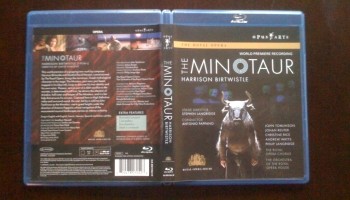 | 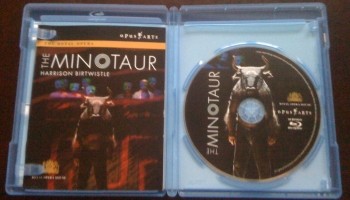 |
Video and Audio:
As with many of OpusArte's other high-definition releases, Birtwistle's The Minotaur arrives in a 1.78:1 1080i AVC encode that impresses, despite the misgivings that accompany its resolution discrepancy. It's naturally softer and doesn't move quite as effortlessly as a 1080p image, but that fact's quickly forgotten upon viewing the performance. Skin tones, textures in the Minotaur's head piece, and the many scratches in the wall behind the players are captured with precise detail. Contrast remains deep and pleasing, yet gradating downwards on the actors during spotlit sequences naturally.
Adorning the fine high-definition image, the DTS-HD MAster Audio track mirrors the visuals with sumptuousness that preserves the theatrical experience. John Tomlinson's vocals become a test for mid-range sound design, something that OpusArte's disc precisely handles. The rest of the vocals from Christine Rice and Johan Reuter are equally as powerful, though the audibility is naturally a few degrees lower than Tomlinson's robustness. Musically, I couldn't have asked for more from the presentation of the orchestra; thundering from the drums, fluctuating woodwinds, and the occasionally high-pitched shriek echo through the bizarre modernist concoction at play here, and it's magnificently pitched. Subtitles, which are fairly necessary, are available in stark-white text in English, French, German, Spanish, and Italian.
Special Features:
Aside from the Cast Gallery (:27) and a lengthy, solid plot Synopsis (7:19, HD AVC) that accompany most OpusArte releases, Birtwhistle's The Monitaur also comes with an enlightening feature entitled Myth is Universal (32:20, HD AVC). Interviews with the opera's crew, which include stage director Stephen Langridge, librette author David Harsent, actress Christine Rice, and Harrison Birtwistle himself adorn the feature, where they discuss the symbolism and structure of the Minotaur myth and what they had to do to shape the production.
Final Thoughts:
Within its brooding excitement, bold but streamline visual construction, and fixating trajectory across the Royal Opera House's stage that mixes static and brashly flailing motions to equal measure, Birtwistle's The Minotaur is a transfixing take of mythology that's astounding to behold. Its artistic whims and its performance potency craft it into an accessible and vocal-heavy Grecian tragedy, one that carries a certain poetry about its content. OpusArte's Blu-ray looks and sounds great, earning it a High Recommendation.
|
| Popular Reviews |
| Sponsored Links |
|
|
| Sponsored Links |
|
|
| Release List | Reviews | Shop | Newsletter | Forum | DVD Giveaways | Blu-Ray | Advertise |
|
Copyright 2024 DVDTalk.com All Rights Reserved. Legal Info, Privacy Policy, Terms of Use,
Manage Preferences,
Your Privacy Choices | |||||||









